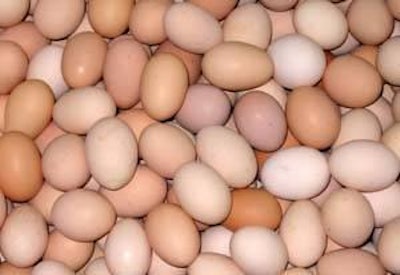
The Accredited Certifiers Association has drafted a guidance document for organic poultry production. The intent is to codify space requirements which will conform to EU standards. The National Organic Standards Livestock Committee is scheduled to revisit these certification standards which are based on “natural behavior of animals.”
The proposals issued on June 5, include the following requirements:
-
Access to dust baths or litter
-
Areas of retreat in both houses and outdoor areas
-
Perches for layers
-
A minimum of 30% of the area of floor houses must comprise litter
-
Sufficient exit area along the walls of houses to allow outside access
The guidance document specifies “an area equal to ten linear feet per thousand square foot of house space”. Since the terms “area” and “linear feet” are inconsistent it is assumed that the vertical and horizontal dimensions of the openings provided, should amount to 10 linear feet per 1,000 square foot of floor area.
Floor requirements
The most important restrictions in the proposed standards relate to floor area:
- Indoor floor space: 1 ft²/pullet and 1.8 ft²/laying hen
- Outdoor runs: 2 ft²/pullet and 2.7 ft²/laying hen
Using a typical converted broiler breeder house or a purpose-constructed slat-and-litter floor house 400 ft by 50 ft in extent, the flock would comprise 11,111 hens at a density of 1.8 ft² /hen. The outside area would extend 75 feet from the long wall of the house to provide 30,000 ft² for the flock. This would markedly restrict the number of houses per farm and would effectively prevent existing and proposed in-line and multi-house floor and aviary units from complying with organic requirements based on the area required for outside access.
The proposed standards also state that birds must not be confined to houses due to a threat of an outbreak of disease. Confinement is permitted however if there is a documented occurrence of a disease in the region or migratory pathway or in the event of a state or Federal advisory. It is also stated that producers must “identify how they plan to protect birds from disease and predators.” Generally, shade cloth is used to prevent contact between free living and predatory birds and producing flocks. An area of 30,000 ft² with shade cloth protection is impractical for a flock of 11,111 hens.
Organic impact
The proposed standard, based on EU requirements will clearly impact, if not disqualify commercial-scale production of organic eggs. The National Organics Standards Board was unable to state or justify a specific area requirement when the regulations were originally established, allowing domination of organic egg production by commercial farms responding to free-market supply-and-demand considerations. Should organic egg production be seriously curtailed over the five year period of implementation of the suggested standards, the net result would be that the major food distributors and retailers will be unable to obtain adequate and regular supplies of product. The cost of production would escalate further curtailing demand. Organic egg production will contract to a group of small-scale producers supplying local outlets.
Current family-owned and corporate producers of organic eggs will revert to cage-free status based on their existing investment in housing and facilities which may range from $15 to $20 per hen for converted housing and as much as $35 per hen for advanced aviary installations. The proposal to extend space requirements and especially outside access without any scientific justification will be ultimately destructive to the organic egg production sector of the U.S. industry and to the certifying agencies without producing any tangible benefits in terms of welfare, food safety or consumer satisfaction.
It is inevitable that if the suggested standards are adopted that existing commercial producers of organic eggs may well develop a new category of product based on organic feed, drug free systems, high standards of hygiene and safety which are not currently addressed in the NOP requirements. Although these eggs will not be eligible for the “USDA Organic” logo, the product will be available in sufficient quantity and at a price which satisfies demand. A concerted educational campaign for consumers and the support of the supermarket and institutional sectors for a wholesome egg product conforming to existing organic production standards will be required. USDA-Certified organic product will revert to the mom-and-pop producers with limited resources, and possibly questionable food safety. To justify the proposed regulations on the basis of “harmonization with the EU or Canada” is fallacious since there is no trade in organic eggs within NAFTA or to the EU. Given the proposed regulations future exports would appear even more remote.
There is an obvious need for common sense in the selection of standards and evaluation of organic requirements and the design of future production systems. Standards should take into account science-based practices and economic realities. Certifying agencies and the NOP should assess the impact of “moving the goalposts” after an industry has been created and investment committed to a market segment.

















